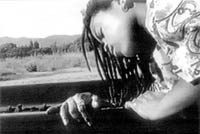
Documentary | Film Festivals | Filmmaking | Interviews | Massachusetts
Filmmaking on the Edge
Written by Devon Damonte | Posted by: Anonymous
C.A. Griffith is the director of "Border. Line… Family Pictures," winner of the Visions In Color Award sponsored by FilmShack at the 25th New England Film and Video Festival. Griffith is currently a Five Colleges Visiting Assistant Professor of Film/Video Production at Smith College and the University of Massachusetts. She was one of the first black women professional camera assistants and cinematographers in the film industry, and her credits include "A Litany For Survival: The Life and Work of Audre Lorde," "Eyes on the Prize II," "Juice" and music videos from Tracy Chapman and Public Enemy to the Rolling Stones.
DD: In the opening of "Border. Line… Family Pictures," you make great use of the disparity between the tough, very poor neighborhood of East Palo Alto, Calif., and the extreme affluence of [Palo Alto and] Stanford University a few short miles away. This is one of the most pronounced differences in bordering environments anywhere. Had you lived there, or how did you experience that?
GRIFFITH: I was an undergraduate at Stanford, and while I was there, I worked to get through school. I had a job as an assistant to a photographer whose studio was in a converted laundry in East Palo Alto. Every day I would ride my bicycle from Stanford to East Palo Alto, so I experienced travelling between those worlds every day. Also, I was raised in Washington, D.C., in a cozy, middle-class enclave bordering a poor and "tough"
neighborhood. When my family moved there in the late ’60s, the racial tensions and boundaries were very marked. My parents are both activists who wanted their children to grow up with a strong sense of community, and the realities of class and race weren’t things that they tried to gloss over for us. It was a difficult but really eye-opening place to grow up, and it shaped me in many ways.
When I was in New York, I lived in the Washington Heights area [and other places in Manhattan and Brooklyn] which were also very much "borderline" communities. So I guess I’ve almost always lived in these sorts of places, being aware of living on the edge of one neighborhood that was very different from its neighbor.
DD: So how much of "Border. Line." is autobiographical?
GRIFFITH: In some ways it is my story, particularly in terms of a sense of alienation. But many other elements are purely fictional. I had wanted to do a documentary on the Pullman Porters for a long time. There’s a doc called "Miles of Smiles" that inspired me. I did a lot of research, some of which made it into this piece. But my grandfather was an A.M.E. [African Methodist Episcopalian] pastor, not a railroad worker. I took some elements from my own experience and borrowed many details from friends and schoolmates. When I was a grad student, I really did have the experience of discovering a historic photo of African American railroad workers in an antique store, but finding it was far too expensive for me to afford.
DD: You now live in Springfield, Mass., and I wonder if there’s any similarity to the East Palo Alto/Stanford situation living there and working in Northampton and Amherst.
GRIFFITH: (laughs) Yes, it does do somewhat the same thing. Many of my colleagues think I’m crazy to commute, or get scared that I’m going to be knifed on the way to work or something! But I really like living in Springfield. It’s a very vibrant and diverse community. Northampton feels very protected and isolated at times.
DD: "Border. Line." felt to me to be very much about place, home, familiarity and uneasiness with environment and cultural signifiers and perceptions. In a sort of related way, the New England Festival is all about place, in the sense of identifying artists by the region in which they live. What are your impressions of this region, and do you plan to stay here after your stint at the Five Colleges?
GRIFFITH: I was born in Boston, but left when I was three and moved to Washington, D.C., and then spent most of my adult life in California. People on the east coast consider me a California filmmaker, and people on the west coast say I’m an east coast filmmaker. I’m somewhat ambivalent about where I’ll go next. There’s advantages and disadvantages every place. Here I appreciate the intellectual community and that you can drive a relatively short distance and see very different people and things. I was hired as a visiting Five College faculty based at Smith and UMASS on a two-year contract and am in the third year of a renewed contract. I was offered a faculty position but felt it was better to finish off my contract and explore other options.
There is something about Springfield that I really like. It has a mixed community, and it’s also centrally located in the middle of everything between Boston and New York and other places. New England feels very invigorating for me. And I really love teaching.
DD: Do you feel a difference between the film community here in New England versus other places — California and elsewhere?
GRIFFITH: The community I knew in California was centered around being in grad school. The only other film community I’ve really felt a part of was during the years I spent as a film professional in New York after undergraduate studies, and of course being connected to all of that was very vital. Here in the Five Colleges I feel lucky to be amidst so many nationally known film and video talents, and I’d like to be able to make more connections with them, but we’re all so busy between teaching and our own work. In California it’s different, because you basically have a community in Los Angeles and another community in San Francisco. They’re so far apart, and they’re different. On the east coast, there’s people everywhere and closer together — in Philadelphia, Boston, New York, Washington D.C., etc — and it creates a very interesting dialogue.
DD: Your feature film "Del Otro Lado (The Other Side)" has received quite a lot of attention and acclaim . How is working on a narrative feature different than doing short experimental work?
GRIFFITH: "Del Otro Lado" came about through a friend — one of the lead actors — who I have known half my life, and we had always been talking about working together. Earlier on, he was in San Francisco and I was in New York working as an AC and director of photography (DP). By 1997, I was on my way back east to teach after grad school at UCSB, and he sent the script to me. I thought he probably wanted me to do the cinematography for it, and as we talked more, he asked me if I wanted to direct. He showed "Border. Line." to the other lead, his co-writer, and they called me and said they wanted me to direct it. Because I had so much professional experience working on crews, I knew the mechanics of low-budget feature filmmaking very well. But I didn’t know if I would like directing or if that angle would interest me. It was a huge challenge, particularly to direct people in various scenes while maintaining the big picture in my head. We also shot on our low peso production on location in Mexico. I really liked directing. Speaking fluent Spanish and having a background as a cinematographer helped immeasurably. I still love shorts, and I love docs, which was where I first had the most experience, and between that and features and teaching, it’s just a matter of keeping it all going.
DD: Was it difficult making the transition from camera assistant and DP to director?
GRIFFITH: I had a severe back injury while ACing (camera assisting) on a feature almost ten years ago. I’m basically in some degree of constant pain, and with lifting heavy cameras, there is just no way I can do that work the way I’d like to. If you’re not doing camera operating and lighting all the time, you can really lose that edge. I still do it occasionally for friends, but I really miss it on a regular basis. But then again, the detour led me into writing and directing. I did "Border. Line." in video for my MFA thesis project at UC-Santa Barbara. Small formats have made camera work a whole different ball game. There’s things you can do now so simply with one person that used to require huge film rigs and special film stock and special lighting equipment. It creates a lot of options. But of course at some point you’ve got to edit the thing. It’s been very good for people who have the ideas but little money, and it’s opened up doors for the field — a very exciting development.
DD: What did you do on the "Eyes on the Prize II" project?
GRIFFITH: I had quite a lot of experience doing AC work professionally, and I actually started out in the art department, and I was being groomed for production design. But I really wanted to be a cinematographer, and at that time people thought I was crazy as a woman wanting to do that. Fresh out of Stanford I moved to New York and met the most amazing people. One year later I was ACing for St. Clair Bourne on a "National Geographic" doc and on tour with Depeche Mode for a doc by D.A. Pennebaker. I was freelancing and got hired to work with both Bobby Shepard and Michael Chin on "Eyes." So I was in various places, not in Boston at Blackside, but Henry Hampton definitely had a big influence. That was an incredible experience. I couldn’t believe I was getting paid for this job to record people who made history.
DD: What upcoming projects are you working on?
GRIFFITH: I have a screenplay that has made the finals of the Sundance workshops twice now, and they tell me the third time is a charm. But I’m working on a couple other screenplays, one for a short and another for a feature. Meanwhile, my partner and I are working on finding additional funding for "The Angela Davis Project." It’s a video documentary series with Angela Davis having conversations with several women of color cultural workers. This really came out of an experience I had working on "Eyes" with the ten minutes of film in a 16mm camera magazine. Each time we’d have to change magazines and sound reels, the talent would relax, and these amazing things came out in conversation that wouldn’t come out in an interview. We’d seen documentaries on Angela Davis, and we were very interested in what would happen with her, not as an interviewer at all, but in conversation, to see different sides of these women and her from the radical activist that everyone knows. So far we’ve shot Davis talking with Yuri Kochiyama, a 75-year-old grassroots political activist, and we’re planning conversations with director Julie Dash, poet June Jordan, and writer/activist Elizabeth Martinez. So now it’s a question of finding the money to make it happen.
FilmShack is a fully integrated company, providing one-stop shopping to the film and video producer. The Vision of Color award is intended to encourage filmmakers of color and help them capture their stories so they may share them with us all. The award offers equipment services and consultation for the winner's next project with FilmShack producers and directors. For more information on FilmShack, contact them at 617-989-0588. 'Border. Line...' will be showing with 'Dog Days' on Friday, March 31, at 8:00 p.m. at the Museum of Fine Arts. For tickets and information, visit https://newenglandfilm.com/festival or call 617-536-1540 ext.18.









